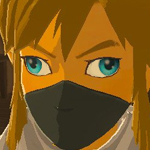 Final verdict: B-
Final verdict: B-
Final playtime: 100+ hours
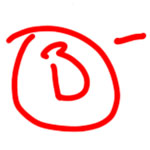
Sometimes you gotta review the little titles, you know? The lesser known gems. The diamonds in the rough that everybody else overlooks. So this is a new game called The Legend of Zelda. I guess Nintendo must be going for the high fantasy D&D crowd with a name like that.
“Oh, Shepton!” you whinge, like an infant would. “Stop with your silly japes!” Fine. Fuck you. I only wanted to put a little humor out there and you RUINED IT. Why you gotta be such a hater? Don’t you know haters get left behind? That’s you, man. Left behind like a fuckin’ HATER.
[WARNING: SHEPTON RAMBLES FOR LIKE 6 MORE PARAGRAPHS. CLICK HERE TO SKIP TO THE ACTUAL REVIEW IF YOU WANT]
I’ll be honest, I had a lot of assumptions about this game before playing it. I’d watched more than enough footage and read more than enough reviews from corporate shills. I watched, aghast, as the hype train blew right through the station packed with more people than rush hour in Beijing, all holding up signs in the windows saying “10/10.” I knew these scores couldn’t be the case, because fundamental logic tells me that a perfect score should only be awarded to a perfect game. And a perfect game does not exist. There is no such thing. Every game has some flaws, and a game as ambitious and substantial as this one could only logically be riddled with its share of them.
But here’s the thing: This one’s called Zelda. This hype train was of the Bullet variety and could not have been faster or more dangerously packed beyond capacity. The perfect scores across the board didn’t surprise me. It’s pretty common knowledge that I have a very cynical opinion of the video game review industry. I don’t trust it. There’s too much money involved. Most major reviewers receive ad revenue from the publishers of the games they’re reviewing, so of course they’ll say good things. They’re also forced to pander to a rabid, savage readership who passionately and viciously attack anyone who dares criticise a game that they love simply because of its name, even if they haven’t played it yet because it isn’t even released for public consumption. That’s just the way things are. It’s a part of why review sites are often criticised for having a “7-10 scale” – because they daren’t ever rate lower than 7 on major titles for fear of backlash, because for whatever reason these days 7 has practically come to mean “terrible, worst game ever.”
I’ve always thought that 5 should mean “average, totally playable, you could still have some fun with this title despite issues.” A mid-point. Maybe you’ll really enjoy it, or maybe it really isn’t for you. Surely that’s what 5, the middle of a 0-10 rating system, should mean? Ultimately then, a 7 should probably mean something like “Above average, more fun than not, mostly enjoyable experience, has some issues” but if you saw the reaction to Jim Sterling’s 7/10 review of Breath of the Wild you’d think he had personally murdered the beloved family dog of each and every Zelda fan the world over. Anyway, rambling aside, that’s why we use the letter grade system. The idea behind that is that maybe it’ll be a more familiar system to people, and suggests the overall vaguery and subjectivity of the very concept of reviewing games a little better than a hard numerical value. We’ve all been through school, we get it. And just maybe it’ll be easier to understand exactly what it means as opposed to a number on a scale that may or may not be treating 5 as its center.
All cleared up? Did what I just drone on about make sense? Good. I’m glad. Because truth be told I was dreading writing this review as much as I was looking forward to writing it, and I want everyone to get where I’m coming from before reading it. This is the big one. Nintendo had a lot riding on it. It’s launching a new system for them, and it’s a fucking Zelda game. It had to be good. No, it had to be perfect. And to hear the masses tell it, it was that and more. It apparently went beyond anything that the medium has done in the past. It has transcended all genres and is the best video game EVER CREATED! Finally, something to surpass Ocarina of Time! Trying to write honestly and subjectively about something as big and beloved as that can be daunting. I mean, around here we tend to be the critical, skeptical type. And critical, skeptical types tend to receive threats of physical harm and wishes of cancer and/or rape on the internet. And that isn’t fun!
But hey, being critical and skeptical is kind of our schtick. Without that edge, we’d be nothing. NOTHING! Our honesty and integrity is all we have, dammit! So of course I’m going to shit-talk Zelda! Why the fuck would it be good, EVER? They went open world for fuck’s sake! That’s TERRIBLE! Why turn something as historically fun as Zelda (at least, you know… recent history not included) into a god damn collectathon follow-the-line checklist game? FUCK you, Nintendo! This game looked like it was gonna be shit, but I wanted a Switch so I could play games during my commute every day to pass the time, and Zelda and Shovel Knight (fucking excellent game, by the way, I don’t know why it took me this long to finally play it) are the Switch’s entire library right now. So, fine. I’ll play Zelda! I’ll even REVIEW it! I’ll say BAD THINGS about Zelda on the internet, and I’ll get fuckin’ CRUCIFIED!
But then the unthinkable happened: I actually enjoyed Zelda. For the most part, at least. Like I made clear above, perfect games are essentially impossible to come by. Games are art, and art is subjective. Even if I did consider a game perfect, the next guy might not. He might wipe his ass with my idea of perfect. He might even hang the damn roll under instead of over, like a caveman. And apparently my idea of perfect is wildly different from the established game review industry, because I did not think this game was perfect by a long stretch. But being critical of Breath of the Wild is now the cool edgy counter-culture thing to do, so I can’t win no matter what grade I give this shit. But anyway, I thought it was mostly good, it was a genuine pleasure to play, and I invested a lot of hours into it, but it had some fairly ugly flaws that shouldn’t just be swept under the rug.
So there you have it, folks. Eight paragraphs in and the verdict is out: Game’s pretty good, you should probably play it. Review over. You’ve heard enough… of my secrets.
Man, I always promise myself I won’t do this next time. I establish so much shit for an entire review’s worth of text before even talking about the damn game. Sorry. My bad. It’s how I do things, okay? It’s important to me that I’m understood, and this leads me to expound for paragraphs and paragraphs to try and make sure everybody’s on a level playing field and gets the perspective that I’m speaking from. UNDERSTAND ME!
[ACTUAL REVIEW FINALLY BEGINS]
The Legend of Zelda: Breath of the Wild. It’s here, the new Zeldie! Nintendo put themselves in an interesting position – they’ve been consistently disappointing everybody with Zelda for a long while now. Depending on who you talk to, Zelda hasn’t been good since the N64, but the N64 titles were so beloved that any new Zelda ultimately gets compared to them while ignoring everything that came since. So on the one hand there’s a perceived pedigree that they have to live up to, but on the other hand they’ve been letting everybody down for a over a decade and how could they possibly do worse than Skyward Sword? Amazingly, they shocked even me by taking the leap to open world. Wow. They really are going to make it worse than Skyward Sword! I thought it couldn’t be done, but against all odds they found the only way to top it! Or should that be “bottom” it?
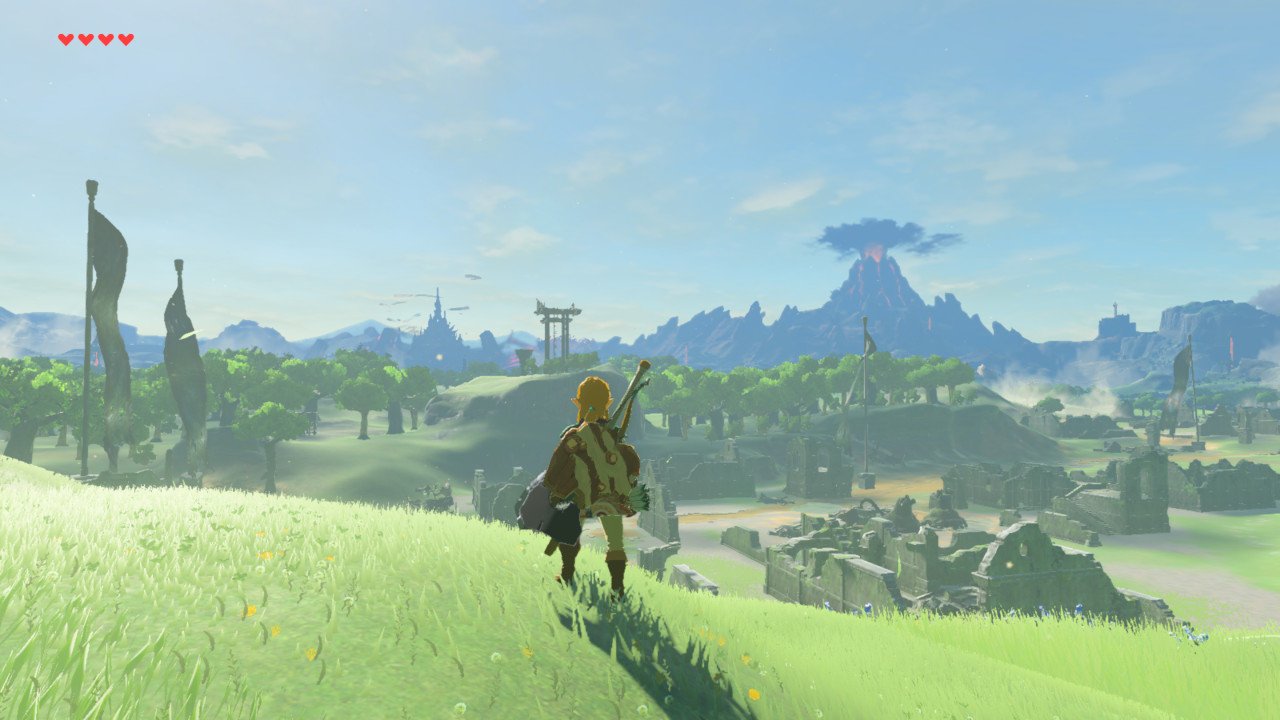
I watched hours of footage leading up to this game’s release, and post-release. Not just review clips but hours-long streams of real people just playing it for fun so I could get a sense of what the game really was about, and most of what I saw disappointed me. The way it imposes a need on the player to constantly make food, replace equipment, travel long distances slowly, fulfill banal requests from NPCs to collect ten of something, exploration only being rewarded by mere consumables and nothing special or unique… Everything wrong with the entire open world concept seemed to be present here based on what I was seeing. It was what I expected from an open world game. My only disappointment was that there weren’t as many voices coming out pre-release saying that. Everybody was too busy with the circlejerk about how good and perfect it was going to be. But there were elements that I did like, things that gave me hope. I kept hearing that “it’s just like the first Zelda game on the NES!” being thrown around as praise. That in itself could have meant many things, but it seems as though the crux of it is that most of your guidance is given to you through dialogue, sign posts, or natural environmental clues. If you want to find something or solve a puzzle, you need to figure it out yourself because the game isn’t going to just tell you. You know, like games used to be. In the Before Time. The Long, Long Ago. I’ll give it props for that – they really made it work. I turned the HUD to “pro” mode immediately, so the only thing displayed on screen is your hearts, and I didn’t feel as though I was missing a damn thing. In fact, I loved it that way. It felt freeing and refreshing to have such a simple and clear screen with no clutter. None of the extra stuff was necessary. So yeah, Breath of the Wild definitely doesn’t feel like it’s holding your hand too much. The first couple hours are a little bit guided but it soon sets you free like a baby bird falling from a nest. Unfortunately the floor is basically a giant mattress and there’s no risk because dying has no punishment. Upon death you immediately restart unharmed and with all of your items, almost exactly where you died. You don’t even lose time. Just bam, right back into it!
I get that can be a difficult balance to find. What should the punishment for death be? If it’s too harsh, people will get frustrated. If it’s too lenient, people won’t try to get better at it because it’s not like anything bad will happen if they fail. And I’ll also say it’s not easy to die in Breath of the Wild, regardless of what everybody is saying. “Oh things kill you in one hit! It’s so hard!” Fuuuck you. This game is putting huge amounts of effort into keeping you from dying at all times. You even get an ability that saves you from death and adds a bunch of extra temporary hearts to your health bar if you take a killing blow. If you’ve caught any fairies they’ll keep you alive as well. And if you aren’t a total reet you’ll have a fully stocked food inventory at all times to keep your health up, and you’ll keep your distance from stuff that will one-shot you and fight cautiously. All it takes to prevent death is a little common sense. Shocking, right? It’s the same reason you’re here reading this right now instead of dead ten years ago from not looking both ways when you crossed the street. This shit ain’t hard, people. Just don’t fucking die.
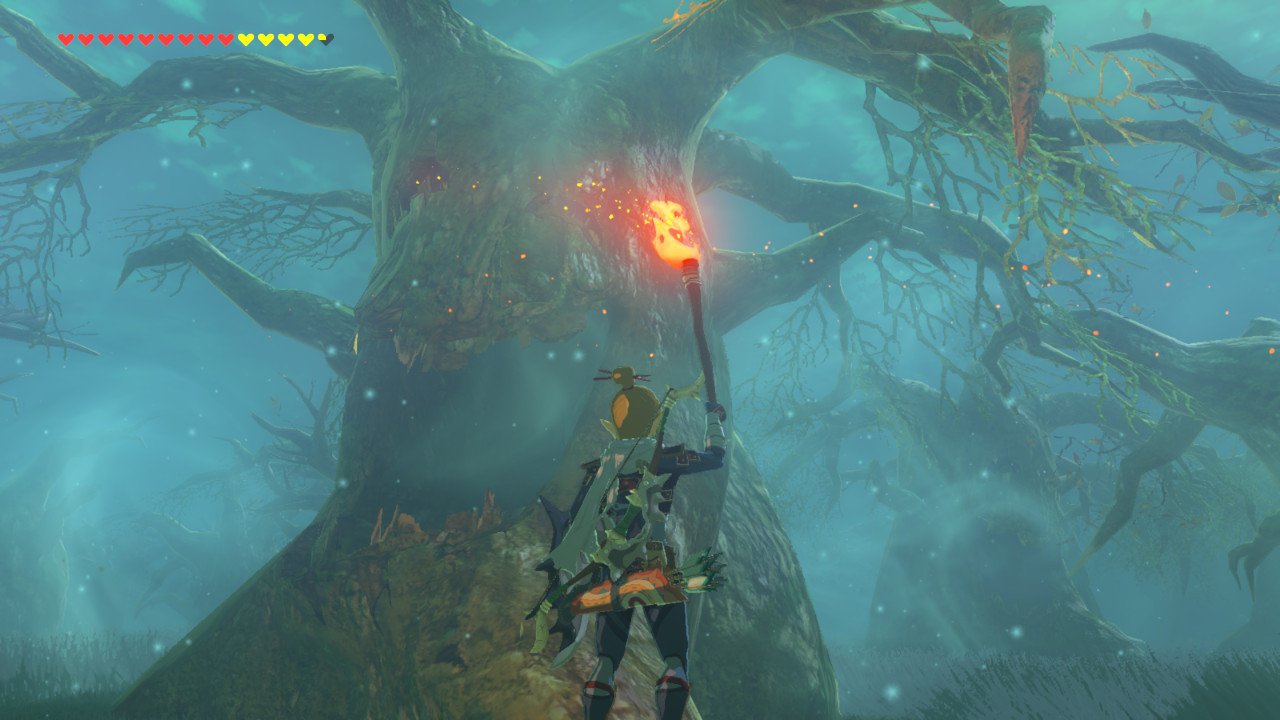
Needless to say, Nintendo is really pushing the nostalgia angle. A lot about this game can be compared to Zelda’s roots on the NES, the non-linear dungeon order being the biggest and most obvious factor. The difficulty is superficial. The original Zelda was legitimately difficult, this only pretends to be. But nostalgia is the theme of the day – that’s what they were going for, and it gets the job done in that regard. The nostalgia runs deeper though – Breath of the Wild leans heavily on Ocarina of Time because Nintendo know damn well that game was Peak Zelda. That was when the bubble was at its biggest and they’re gonna do what they can to resurrect its carcass and put it on display like a disturbing meat puppet. But honestly, I’ll admit to not hating the references to past games. They’re largely pretty subtle. For instance, I was exploring around a forest, checked the map and saw Lake Saria, and Mido’s Swamp. It doesn’t really beat you over the head with it, the references just exist as a little wink to those in the know, and as neat scenery to those who aren’t. I’ll admit my jaw fell open just a little bit and let out a happy fanboyish gasp when I stumbled into a foggy forest and the location text faded in saying “L O S T W O O D S.” That was fuckin’ cool and the little boy in me got REALLY FUCKING HAPPY. I admit this.
Oh, and the music is fucking top notch, too. Several of the tracks contain brief elements from familiar songs from previous games. Like you enter Zora’s Domain and hear the same kind of tones as the music starts, and it reminds you heavily of the Zora’s Domain music from Ocarina of Time, but then it changes and becomes its own song. And the music that plays at stables throughout the game contains elements of Epona’s Song, and there’s even a guy that shows up occasionally playing the original Epona’s Song on an accordian. The entire game’s riddled with neat moments like that, and I didn’t hate it. It felt natural. Self-referential nostalgia is a fine line to walk and can come across as forced or cringey when a game is hitting the “REMEMBER THIS?!” button too hard, but Nintendo brought their A game with it. Of course referencing past games certainly isn’t new to Zelda, I mean so many names and themes that feature in almost every Zelda were established as far back as the NES games, but this one is the first to really use it in a nostalgic sense, rather than “Yeah the name Ruto has been around since a town in Zelda II was named that.” Although I suppose Twilight Princess tried being the direct Ocarina sequel, it just wasn’t particularly loved. Breath of the Wild seems to heavily suggest that this is the future of the Hyrule we saw in Ocarina, and even Termina from Majora’s Mask. I mean I found a pond near Death Mountain called Gero’s Pond which is similar in shape to the pond where Don Gero’s frog chorus is in Majora’s Mask, and it even sits in front of a sheer cliff face like the one you had to climb to find Darmani’s grave. Climbing the cliff revealed a bunch of precious ore where Darmani’s memorial cave would have been. But I’m not trying to get into game theory territory or anything, just trying to make the point that Breath of the Wild is going in hard on nostalgia in ways previous Zelda titles have not. I’m sure with the success of this game that Nintendo will put out a sequel to the Hyrule Historia book which will retcon and retell everything that the first book established in order to make Breath of the Wild fit.
When it comes to the writing, the dialogue in particular was solid, consistent, and enjoyable. There’s an excellent balance of light-hearted Nintendo humor and more serious stuff on display throughout. The story-critical NPCs that play major roles in the main quest are fleshed out characters with their own personalities and backstories, and I came to like all of them quickly. Even the inconsequential NPCs that simply exist to populate the world don’t feel like that’s their purpose in the slightest. The most regular of Joes has some motivation and goal. You can talk to some random kid at a stable and he’s got concerns about how his older siblings have more fun than he does because he’s stuck giving people directions, because every stable needs somebody to give directions due to regulations. That kind of self-awareness in the writing is fun, and appreciated, and by no means unique to that one encounter that I just mentioned. There are plenty of times when you’ll get called out for picking certain dialogue options, for instance – if you’re clicking through the text and select whatever option you didn’t pick last time and contradict yourself in the process, it’ll call you out for doing that. It never really felt to me that the NPCs were just spouting the same one or two lines every time you speak to them. They felt like people living their lives, and I really enjoyed interacting with them. I actually found myself looking forward to talking to everybody whenever I found a new town, and every time I was out in the wild and saw a traveling merchant walking with his donkey down the road, or some random folks out camping in the woods, or explorers being set upon by bokoblins, I’d run over excited to see who they were and what they were all about. An open world game has never managed to make me feel quite like that before. Ordinarily I see those situations and think “Ugh, more unfulfilling busywork.” I guess what I’m saying is, good writing can go a long way. Not to say that writing is the exclusive reason these elements are good – it takes a village. I can only assume that getting NPCs and quests and towns and traveling merchants and random encounters in the wild to feel as good as this and work as well as they do must take a lot of good teamwork among the design, development and writing teams. That said though, the overall plot itself isn’t anything to write home about. It’s your standard Zelda, so no surprises there. Ganon bad, Zelda good.
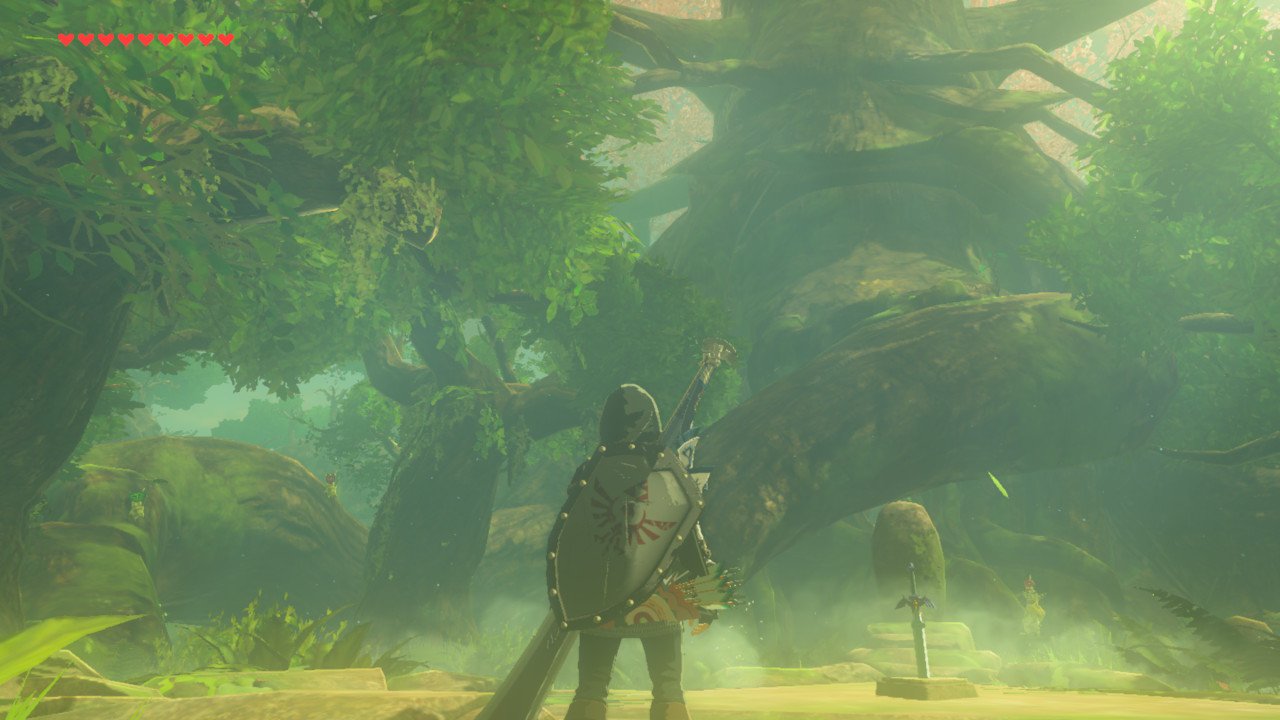
Something I was ready to get my teeth into and talk absolute SHIT about was the seven thousand bajillion dungeons throughout the game. When Nintendo first revealed how many dungeons there would be, everyone was just going insane, acting like there were literally going to be hundreds of fully fledged Zelda-quality dungeons in the game, not stopping for a moment to think that at best they’d be samey copy/pasted algorithmically-generated affairs. It turned out that I was actually a little off-base with my assumption. The shrine dungeons were in no way fully-fledged dungeons, but they surprised me by all being unique. For the most part, the shrines are one or two rooms in size, usually consisting of a puzzle or two that are variations on a theme that utilize one of your abilities. Most are unfortunately really easy and kinda boring and are simply put-the-thing-in-the-hole-to-solve-the-puzzle affairs, but a select few are genuinely challenging, requiring a little logic or lateral thinking to solve. My favorites were the really unique ones like the Eventide Island shrine which is on an isolated island way out in the ocean that takes away all of your equipment and items when you land there, forcing you to survive naked and using only what you can scavenge while trying to locate and activate three switches, one of which is defended by a miniboss. The labyrinth island was also a pretty cool idea. To me, those two shrines alone ended up being more memorable than any of the four main dungeons. There ended up being a few labyrinth dungeons, but I enjoyed the island labyrinth the most.
Ultimately I think the micro-dungeon concept has legs to stand on, but maybe there were too many overall. It’s satisfying to find a shrine and solve its puzzle, but when there are so many it certainly means the overall quality drops and inevitably begins to feel like another open world checklist after a while. I think a nice middle ground would have been to include half as many shrines but make them all a little bit longer with an extra couple of puzzles, and definitely throw in more like Eventide Island. So yeah, I’m kind of on the fence for the shrine dungeons, but this is at least better than the algorithmic auto-generated alternative that so many other games have resorted to. Also, I found it a little odd that most shrines are just sitting there out in the open, but some you need to work your ass off to get to, or you need to do some obscure quest to even make them appear. If there had been half as many and they were all hidden then the act of finding them by itself would have felt much more rewarding, rather than just tripping over a bunch of them on your way to the grocery store. As is, they’re so common they might as well be the Starbucks of Hyrule.
Outside of those shrine dungeons, there are four “main” dungeons. I heard from friends and reviewers that I shouldn’t worry about the micro-dungeons being bad because these big dungeons are just like traditional Zelda dungeons, but I have to assume that those friends and reviewers have never actually played a Zelda game in their lives because these four main dungeons are barely much larger than the shrine dungeons, which was a huge disappointment. They are also almost identical to the shrine dungeons, with the same boring “ancient glowy technology” aesthetic that’s become so ubiquitous in Zelda ever since Twilight Princess and the same exact types of physics-based puzzles that the shrine dungeons include. This was a big letdown in itself, but at least there’ll be cool, unique bosses in each dungeon, right? WROOOONG! I don’t even remember specifics about a single one of them. They weren’t remarkable at all. Imagine if in Ocarina of Time every single dungeon had Phantom Ganon as the boss, and also he was just a black shape with LED strips all over him. That’s all these bosses are, unfortunately. Although to be honest, I can’t even feign disappointment here because I’ve come to expect Zelda’s dungeons to fucking suck these days. The last several generations of Zelda titles have been consistently shedding depth and complexity in their dungeon design, and it’s a real shame. Nintendo have either forgotten how to make good dungeons or simply aren’t interested in making good dungeons anymore. It’s like watching Michael Jordan try to come back to basketball but he’s too old and he can’t dunk anymore, and then he falls down and he’s clearly injured but he’s pretending to be fine but he can’t hide the limp, and nobody wants to say anything and everybody just kind of winces and inhales through their teeth hoping that somebody will help him, but it goes on way too long and when somebody eventually tries to help he pushes them away before finally accepting the situation and allowing himself to be taken off the court, and he insists those aren’t tears in his eyes, it’s just the rain, but this is an indoor basketball court so it can’t be rain. Everyone present really regrets seeing it happen. It’s a sad time for everybody.
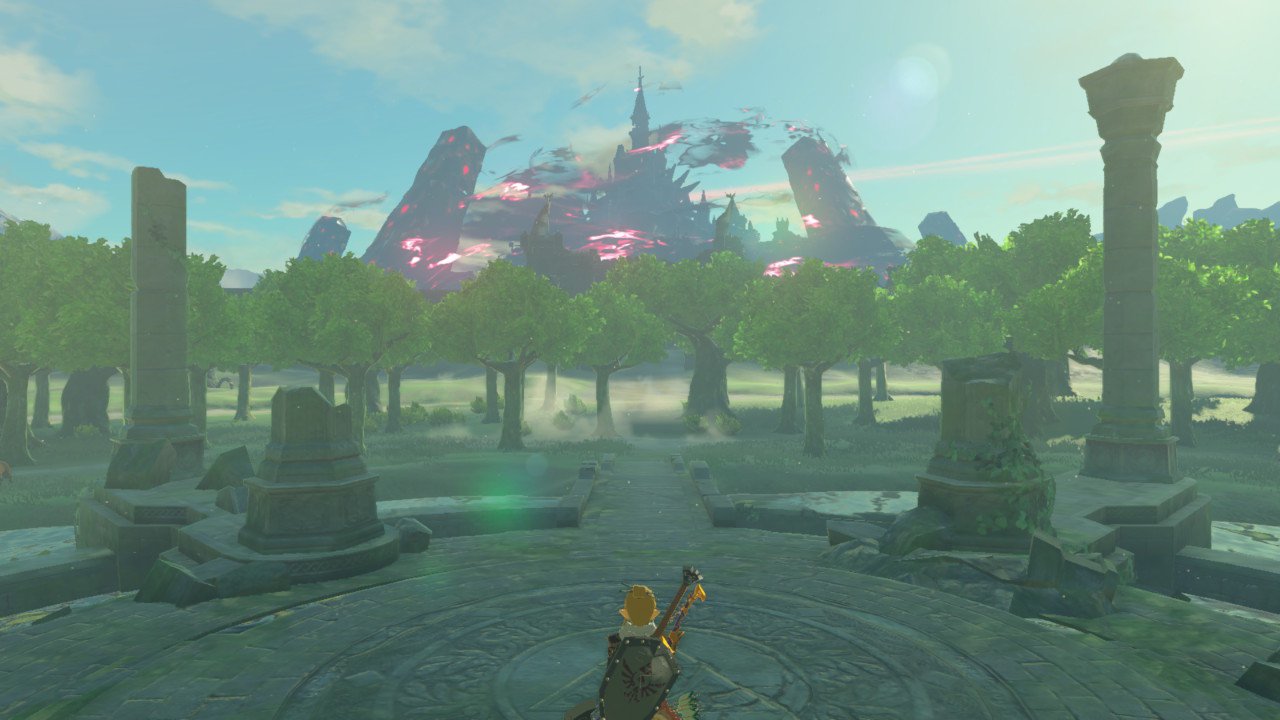
Seriously, I cannot stress enough how unimaginative these dungeons were. They were all really small, short, and simple. The puzzles are all almost identical as well – the idea being each dungeon is a large mechanical creature that you have a small degree of control over to shift its tilt/rotation in order to access other areas. That’s… all there is to them. You can’t reach that point on the map? Spin the dungeon around. Now you can reach it. Puzzle solved, here’s the boss, he’s the same as the other bosses. Finished? Okay. All four dungeons are just two steps: 1) Obtain ability to rotate dungeon (very easy and only takes seconds in each dungeon) 2) Rotate dungeon until you can reach the five buttons you need to press. I think that externally they’re creative – the idea of a few giant mechanical animals roaming the countryside is very striking and cool. I mean, look how great it was in Shadow of the Colossus. But once you get inside them the novelty wears off fast. I’ve given these dungeons way more words than they deserve. A Trump tweet would have sufficed. Sad!
So yeah, I guess what I’m saying is that an abundance of half-decent microdungeons doesn’t make up for a lack of good, substantial ones. Good dungeons are a huge part of what made Zelda so popular in the first place, so for this overall poor showing I award NO PROPS.
Now, what does that mean for the game? Well, without dungeons all we’re left with is the open world. Oh boy. That isn’t sounding promising, is it? But the good news is this game is actually packed with entertaining things to do. I found myself wanting to explore, not for rewards or treasure but simply because the act of exploring was enjoyable. The world, despite being enormous, doesn’t suffer from the copy/pasted feeling that plagues most open worlds. Every area is pretty distinct. Sure, you might begin to notice the same ruined building model being reused after a while, but I found that easy to forgive since the areas where you find them are all overflowing with different hidden treasures or korok puzzles and different flora and fauna. Breath of the Wild is fucking dense with things to do that are actually fun. Take the korok seeds for example – I found that these often satisfied a very basic desire I always feel when playing games. I’ll stumble across something and I’ll want to do something with it. For instance, I’ll see a piece of unique scenery and think “I’ve never seen this, it MUST be special, it MUST mean something!” and attempt to interact with it only to find that it was only scenery after all. In Breath of the Wild, it always does mean something. That weird hole in the ground? Try putting something in it. That asymmetrical arrangement of rocks? Rearrange it and make it symmetrical. That statue holding a basket? Drop an apple in the basket. That one really tall tree you wanna climb? Climb it, and get rewarded for your efforts. These may seem like insignificant things, but they’re little touches that go a very long way. I found that they satisfied a very basic curiosity that I think is innate to most people when they play games. There’s some kind of treat around every corner, and I enjoy that a great deal. It also helps make the world feel much more fully-realized and complete as opposed to just a stage with some lifeless props on it.
Of course that sensation wears off after you’ve done those things a hundred times, and there are literally nine hundred korok seeds to get, but I didn’t go into this trying to get all of them. I went into it with the mindset of getting the ones that I stumbled across or happened to see, and I think that was Nintendo’s intention. They put a deliberately dissuasive number of them in to discourage people from treating them like a checklist that they had to go for and instead treat them as just a feature of the world that keeps exploration rewarding. But when there’s a finite number of something in an open world game, people with too much time will be compelled to get every last one, so it’s not a perfect system. And it should go without saying that, yeah, the shrines and korok seeds do get boring and repetitive. But I personally found that it took a lot longer for me to get bored with this than say, Witcher 3, or Fallout, etc.
Part of the reason I was having so much fun with the open world parts of the game was that everything I did felt like it was contributing to the end goal of fighting Ganon, which is something I appreciate and no other open world game I’ve played has managed to nail that simple thing. For instance, Fallout 4 was all “I have to save my son! But first, let me just go establish dozens of settlements throughout the world and perform countless unrelated menial tasks for strangers.” In Breath of the Wild, Ganon is just a looming threat. There isn’t necessarily any urgency to rush to fight him, he’s just there and he needs to be dealt with when you’re good and ready. Seeing the corrupt Hyrule Castle in the distance reminds you regularly that a threat exists. You want to defeat him because that’s what a hero does. I know I already made a reference to Egoraptor’s Zelda Sequelitis earlier in this review, but this is an important point he made in his criticism of Ocarina of Time: in the first Zelda, you weren’t prompted to do anything. You’re just you, in a world, and there are monsters. Defeating evil is its own reward, and Breath of the Wild recaptures that feeling well. You aren’t doing anything for the rupees, or the bundle of arrows, or the rare ingredients. You’re doing it because you find fighting monsters and defeating evil fun.
God, I can’t believe I’m saying this kind of shit about an open world game. Never in a month of Sundays would I dare to dream this would be possible, and yet here we are. Gotta give props to Nintendo, they still know how to print money, and they’ve managed to turn their attention at least a little bit back to people who enjoy video games! It won’t last though, so I’m not gonna get my hopes up.
Being an open world game, Nintendo of course included item gathering and a cooking/alchemy aspect. The item gathering doesn’t feel like as much of a chore as it can in some games. I almost never found myself having to specifically search for a particular kind of ingredient or hunt a particular animal. You kinda just naturally collect things as you go, and use them up at an appropriate rate, so I never experienced any annoyance with that aspect of the game. I actually found it kinda fun at first throwing items together and seeing what could be made. I appreciated that you could either create food items that served a particular purpose and/or create elixirs using different ingredients that achieve the same thing, so if you’re low on the radishes that give you extra health you can make an elixir with a hearty lizard and some monster parts instead. There’s a few status effects you can get through food – defense up, attack up, resistance to heat/cold, extra health, extra stamina… pretty standard stuff. However, I did find it a little annoying that you can’t stack the temperature resistant status with others. Let’s say you’re exploring Death Mountain, so everything is hot and you need fireproof effects to prevent yourself catching on fire. You drink your fireproof elixir, and you have ten minutes of being NOT on fire. So that’s lovely. But if you eat another food or elixir, it overwrites the fireproof effect with whatever else. Ten minutes wasted. This means you have to carefully stock your food supply with some that give status effects, and some that give only health restoration and don’t do anything else, because anything else will overwrite the fireproof effect and waste all that time you would have otherwise had to freely explore. Sure, not the biggest deal in the world, but exploring hot or cold places is a necessity in this game and it’d be convenient if at the very least the temperature effects stacked with other things. I can understand defense/attack buffs overwriting each other but fireproof effects required for exploration don’t really play a part in combat, so it’d be fine if they were separate and safe from being overwritten except by each other. But even this complaint is self-defeating because the second you reach whatever major city you’re going to you can immediately buy a set of armor that provides the necessary weatherproof status passively, rendering the temperature-based food items entirely useless for the remainder of the game.
There’s actually a lot of those kinds of complaints about several aspects of the game, too. Like how the stamina system is entirely useless and arbitrary. It doesn’t affect combat, just running, climbing and gliding, and you can get around the issue of running out of stamina by simply eating some stamina food. Instant full stamina again and no interruption to what you were doing. And it doesn’t take long to get the climbing equipment and an increased stamina wheel anyway, at which point even the highest cliff can be scaled quickly by jumping up it. So why have stamina at all if you can just negate its negative effects so easily?
Hoo, I’ve said a lot of words. Still with me? Let’s change up the pace a little and get straight into a hot topic about Breath of the Wild: The weapon durability system. Long story short, people are absolutely right to criticize it. It’s fucking garbage from start to finish, but it’s a much deeper issue than just “wah my weapon broke and now I have to find a new one.” The very fact that weapons break, and break extremely quickly, means that nothing is permanent. So if you have a favorite weapon that you wanna use simply because it looks cool, or you like its move set and how it feels to use it? Nope, too bad, fuck off, it broke and it’s gone now. Use this shitty moblin club made out of a branch with rocks stuck in it instead. Oh you don’t like that? TOO FUCKING BAD.
But there comes a point when the problem flips on itself – early in the game everything you pick up breaks in a few hits, leading to a frustrating amount of opening the menu and switching weapons (the quick swap option isn’t much better and doesn’t save much time.) Later on as you start finding more durable and useful items, the scarcity of them leads you to hoard them and save them for bigger, stronger enemies where their use will be justified, but because inventory space is so horribly limited hoarding isn’t an option either and you quickly run out of space because you don’t want to use any of the awesome things you have. Later still, you end up having so many good weapons that even they begin to feel like disposable trash. It’s a shitty system on both ends of the spectrum, without a healthy balance in the middle. I hoped that maybe when I got the Master Sword that it would never break, and simply be a weapon I can use forever, that looks cool, works well, and I won’t need to change weapons all the time. WROOOONG! The Master Sword fucking breaks too. It recharges after a while, but it still breaks so the problem of having to constantly pause and switch weapons mid-combat still exists. What the shit? I had hoped they would at least put one unbreakable weapon in for people who wanted to avoid that awful system, but no. They doubled down on it and flipped everybody off. You want an example of how to do weapons right, take a look at Bloodborne or something. Now, Bloodborne may not be the best example because it had so few weapons overall, but that just made each weapon feel unique and special. Every time you found a new weapon you were like, “Whoa, holy shit, a new type of weapon? Awesome!” And on top of that, you could upgrade even the most basic weapon to make it viable for the entire game. The Souls games all do this. It’s a good thing. I personally like a game where you can find a weapon you like, and hone it, and stick with it, and do your thing. I don’t wanna constantly be picking up shit off the street and using it up like currency. I want to find a weapon and armor that I think makes me look like my personal idea of a badass, and use it almost exclusively, so that I look and feel like as much of a badass as possible for as much of the game as possible. Instead I end up looking like this most of the time:
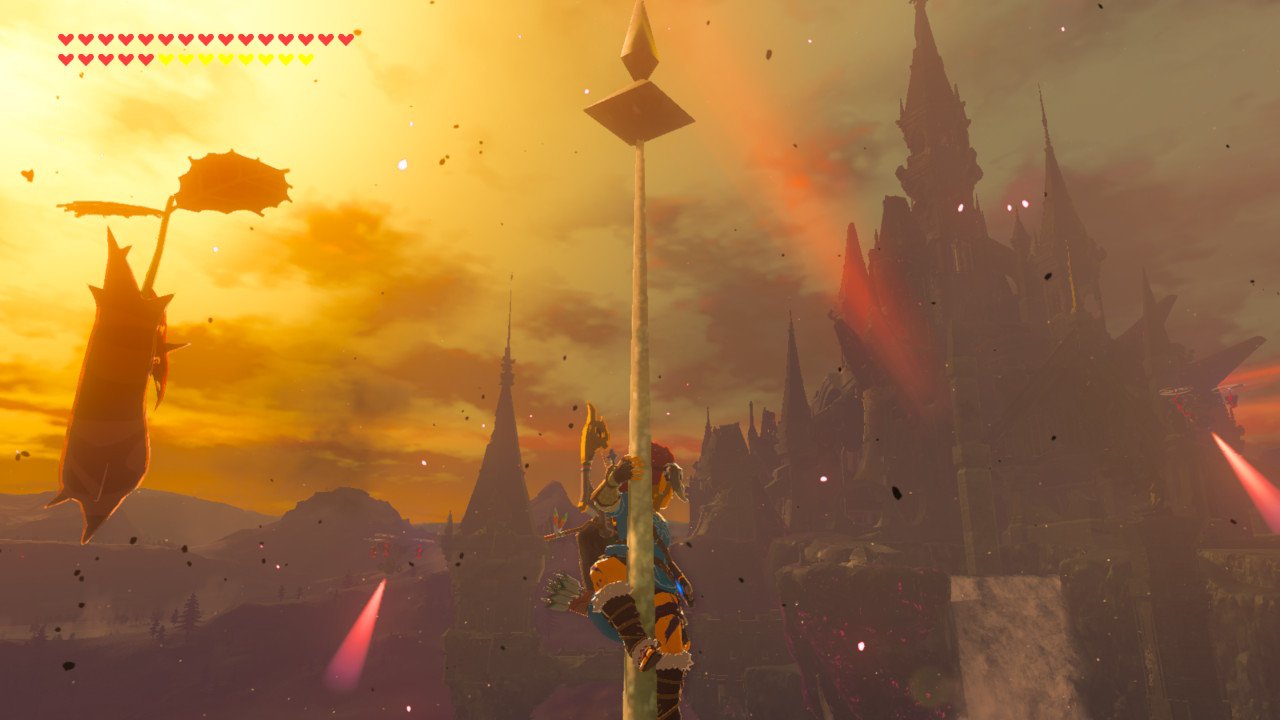
The shields break fast too, and that sucks because they’re almost more precious than weapons since you have far fewer shield inventory slots and they have uses outside of combat since you can use them to slide around on, which is excellent fun, but sliding around on your shield damages and ultimately breaks it, which is fucking ridiculous. This is how the conversation must have gone down at Nintendo:
“You know what would be fun with all these hills and slopes in the game? If you could SURF DOWN THEM ON YOUR SHIELD!”
“Yes, put that in, but make sure that it destroys the shield.”
What the fuck?! WHY?! Why give people something fun to do and then punish them for doing it? I am absolutely baffled by this decision. It certainly doesn’t damage the shield as much as getting hit by enemies does, but still. This bothers me on a fundamental level even if it isn’t a major concern.
Sigh. Anyway, that lets me segue into talking about some more things that I do like, and that is the variety of travel/movement options. The paraglider is incredibly fun and satisfying to use, and essential for quickly traversing the landscape. It’s also really useful strategically. For instance you can scope out an enemy camp, find a high vantage point, glide in silently from above and strike from an optimal angle, or use it to avoid conflict altogether. It’s basically the leaf parachute from Wind Waker except much better. There are also horses in the game, but I didn’t really use them. It feels as though horses were only included because everybody has a hard on for Epona or something, but they’re useless. Fast travel in the form of teleportation is available for places you’ve already visited, and if you’re walking to a new area that you can’t fast travel to yet then a horse just gets in the way because you’ll want to hit up all the shrines along the way and find korok stuff hidden up trees and up walls. And flying from place to place is faster and more convenient than a horse anyway. So yeah, the horses were only in the game to get people to buy the Epona amiibo.
Climbing is a massive part of the game as well. There are a lot of buildings, cliffs, and mountains that all require climbing, so it’s a good thing that the climbing is actually implemented very well (stamina aside). You know when you’re playing some Elder Scrolls trash and there’s a mountain between you and your destination and you’re like “Oh for fuck’s sake, I don’t want to go all the way around this piece of shit, I’ll go over it instead” and then going over it is impossible and takes forever? Never had that situation in Zelda. The climbing is enjoyable and relatively quick, and it’s so easy and seamless that you’ll never see a mountain and groan. You’ll just climb up it, discover some cool hidden shit along the way, and then go about your business, most likely by gliding from the summit going “WHEEEEEEE!” like a gleeful child. Because did I mention that the paragliding is fucking great?
But here’s where Nintendo tripped over themselves again: They came up with a fun thing to do, so now they have to punish the player for trying to do it! Their method for pissing you off in this instance is rain. Now, this is a subject that critics of the game and even loyal fans have come to hate, and I can see why but I’m in two minds about it. Personally, I fucking love rain and the rain in this game is some of the best. It’s up there with Watch_Dogs with how it looks and sounds. Nintendo fucking NAILED the thunderstorms. It feels incredible when the clouds roll in, the skies darken, the rain begins to pour and the thunder rocks the screen. It looks and sounds utterly beautiful, and the atmosphere is perfect. But… rain makes surfaces wet, which makes it impossible to climb. And you need to climb, always. So when it rains your only option is usually to just sit and fucking wait for it to stop. This is also frustrating when you need to light a fire, which is also pretty frequent. At one point I was given a quest to light a torch and bring fire to a series of lanterns and ultimately light a furnace. I reach the fire, bring out my torch, and… it starts raining. The very second I pulled out my torch and needed fire, it rained. That shit is just annoying. The game told me to do something, and then made it impossible for me to do it. Possible solutions could have included making blue flame immune to rain (so as not to fuck up those couple of torch quests), allowing Link to create some kind of shelter to protect camp fires, and making it so the climbing equipment set bonus lets you climb even when wet or something. Then you’d have all the atmosphere, none of the frustration. I enjoy that the rain and storms have a physical effect on the world around you and have ramifications, but when climbing is so essential to playing the game, and the frequent rain makes climbing impossible, that becomes much more annoying than fun. Oh, and taking off certain bits of metallic equipment to avoid getting hit by lightning isn’t too big of a hassle, yet people complain about that like it’s the plague itself or something. It was only a very mild annoyance at worst. Lightning usually ends up being a blessing and hitting enemies anyway, so I’m fine with changing my sword once in a while to let the planet get me some free kills. There are a few locations where it’s storming almost permanently though, so it can be a hassle there, especially when the majority of equipment is metallic and non-metallic options aren’t readily available.
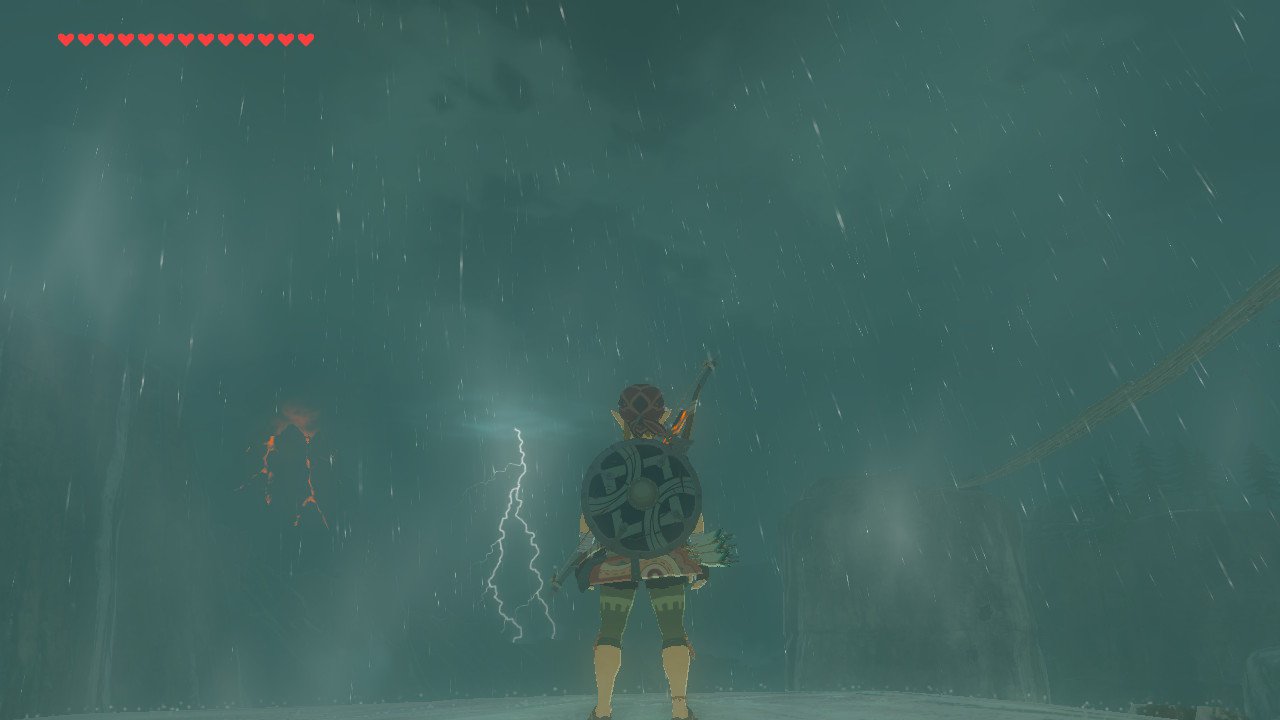
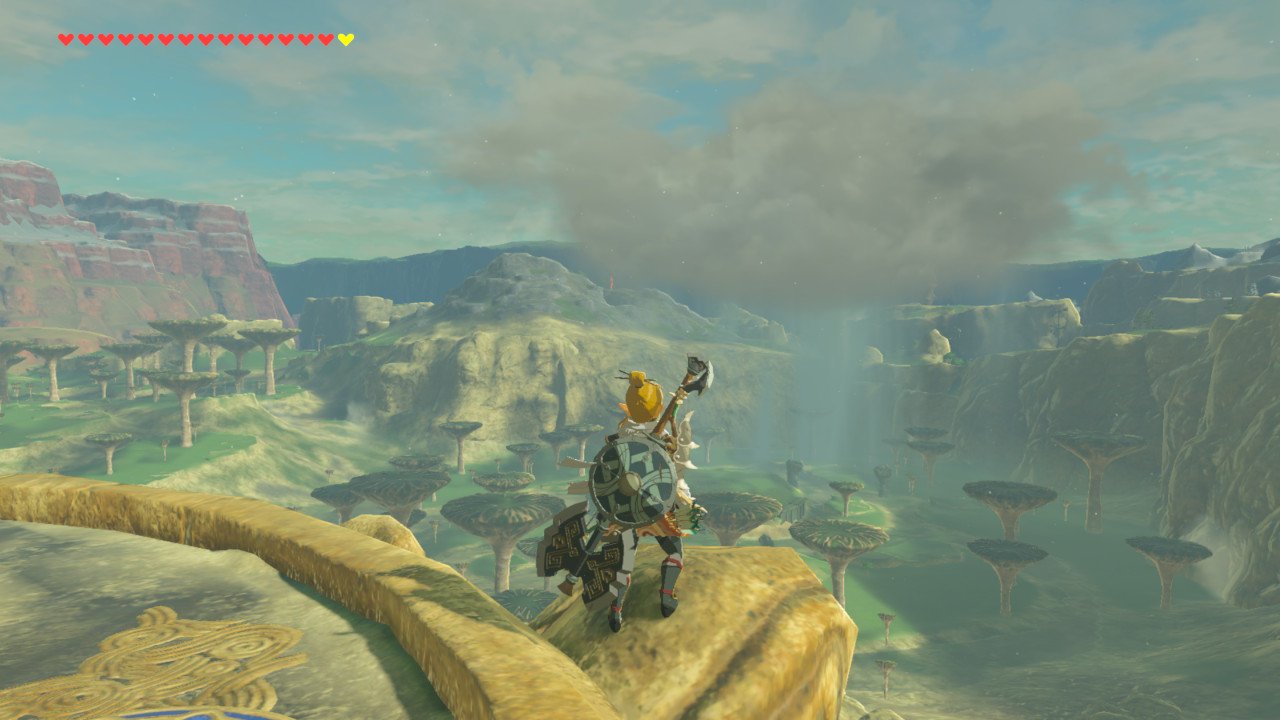
Speaking of atmosphere, Breath of the Wild hits that out of the park in more ways than one. The world has a very physical presence in every aspect, not just the weather. Right when I was just beginning the game I saw one of the Divine Beasts climbing its way around Death Mountain way off in the distance. That was fucking cool, and intimidating. Early in the game you feel very weak and small, so seeing an enormous creature in the distance and knowing you’ll ultimately have to come face to face with it is daunting. I had a similar experience later in the game by random chance. I wanted some fish, so I went to a nearby lake to grab a few. I jumped into the water, started swimming toward the fish I was after, and just happened to turn my camera around in time to see an enormous dragon emerge from the lake a few feet behind me. I nearly shat myself. Bodies of deep water scare the living FUCK outta me specifically because giant sea monsters could be hiding down there, and that is PRECISELY WHAT HAPPENED. It was an absolutely awesome moment and came as a huge surprise. I climbed up outta the water and just watched the dragon fly around for a while, and by total chance a shooting star flew by, so there’s a screenshot of that gorgeous moment below. Sadly these dragons become commonplace very quickly and soon you’re like “Yeah yeah, dragon again, big whoop.”
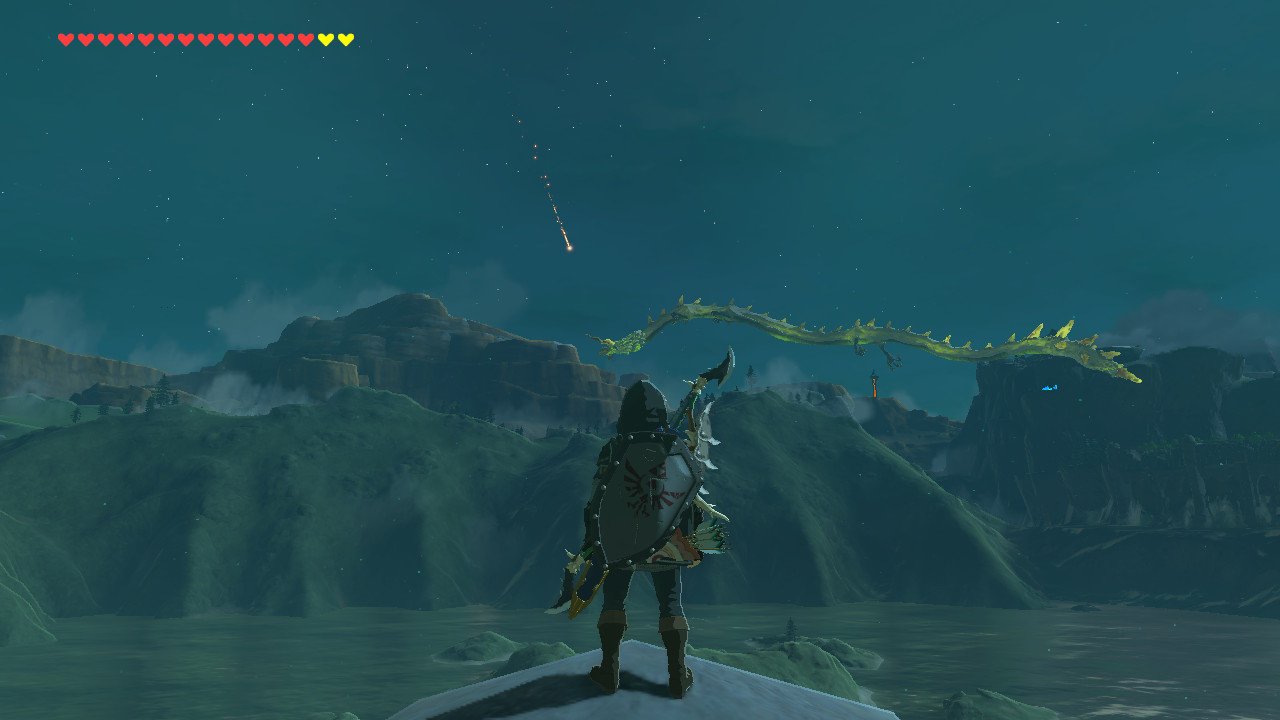
I wasn’t expecting a lot from the visuals department given that the Switch and the Wii U are barely capable of much more than smart phones, but this game is breathtaking to look at. There were so many moments and vistas and spectacles that made me stop and just take it all in for a while, as you’ve probably gathered from the screenshots included in this review. The lighting is perfect. Sunlit moments really shine attractively, and gloomy, rainy weather brings out the depth of shadows and the dark sheen that rain tends to leave on things. It’s a pretty colorful and vibrant game, but it’s tempered by a mostly realistic palette. It’s not full of blocks of solid color like Wind Waker (which was also beautiful, but in a different way.) Needless to say if you want this game to look its best you’ll emulate it on PC in 4k and really crank it up, but that’s beside the point. Beyond the purely visual side of things, the animations are top notch as well. They ride the line between cartoony and believable. Link’s sprint animation for instance, which is something you’ll see all the time, is great. It’s exaggerated and he pumps his arms and legs like he’s in an anime, yet it feels natural somehow. Factor in the satisfying “clink” sound of his equipment that happens when you run and it makes sprinting feel fun.
Performance-wise it’s not great – we’re talking 30fps at best and particularly nasty frame drops can occur frequently, which is disappointing. The Korok Forest and Rito village are some examples of areas with some awful frame rate drops (even after the patch that supposedly improved it), and I experienced countless complete freezes (like a half second or more of 0fps) when killing enemies or breaking weapons, which cause flashes and particle effects which tank the framerate. I can’t speak for the Wii U version because I played on Switch, and as others have pointed out performance is a little better undocked when using the Switch as a handheld. There definitely weren’t as many freezes or framerate drops when playing undocked, but they still occur and you’re also sacrificing resolution and screen size. Maybe that doesn’t bother you though. Whateva.
You know, I wanna take a minute to talk about the Switch real quick since I have your attention – I love this thing. My opinion is that it’s the worst console but the best handheld. If you consider it a handheld device then it’s powerful and feature-rich. If you consider it a home console it’s weak and feature-barren. But since I use it a lot on my commute to and from work every day I consider it a handheld, and it works fucking great and has a large, bright screen and pretty decent controllers. And acceptable battery life, too. Sadly the screenshots it takes are garbage. Sorry about that. I’ll hook up my capture card from now on. I was lazy wanted to test out the Switch’s capabilities for this review.
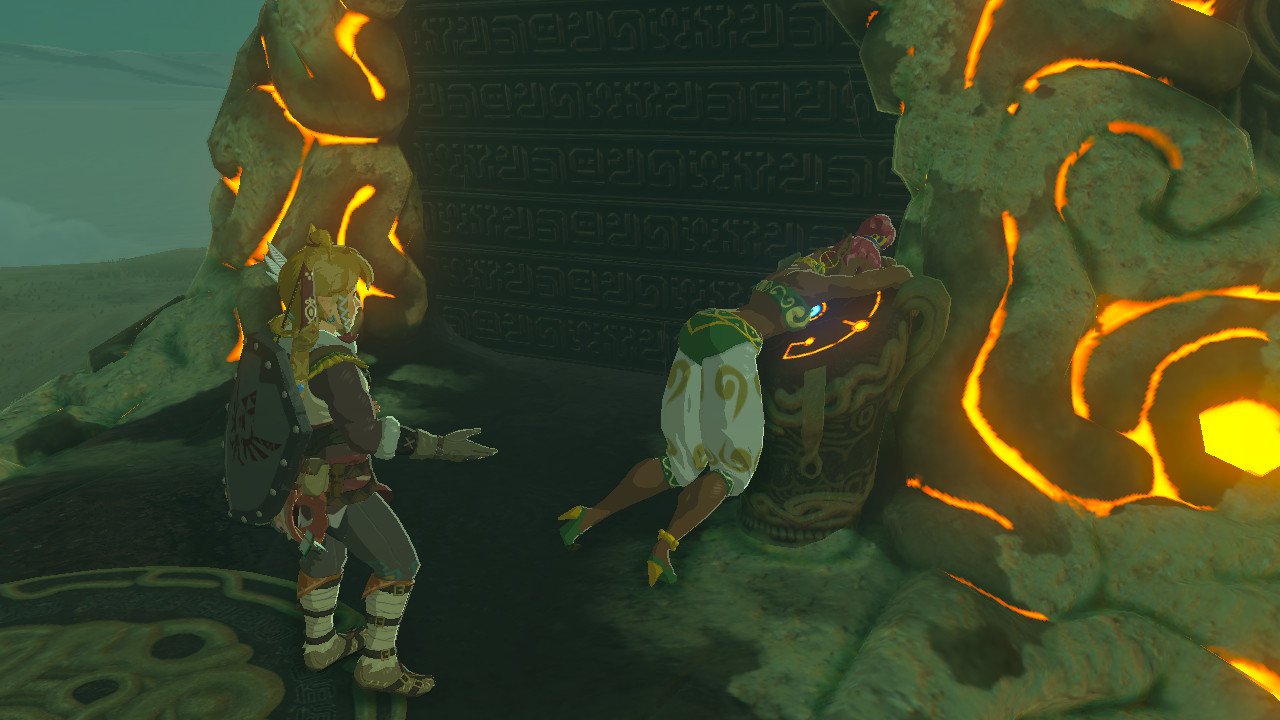
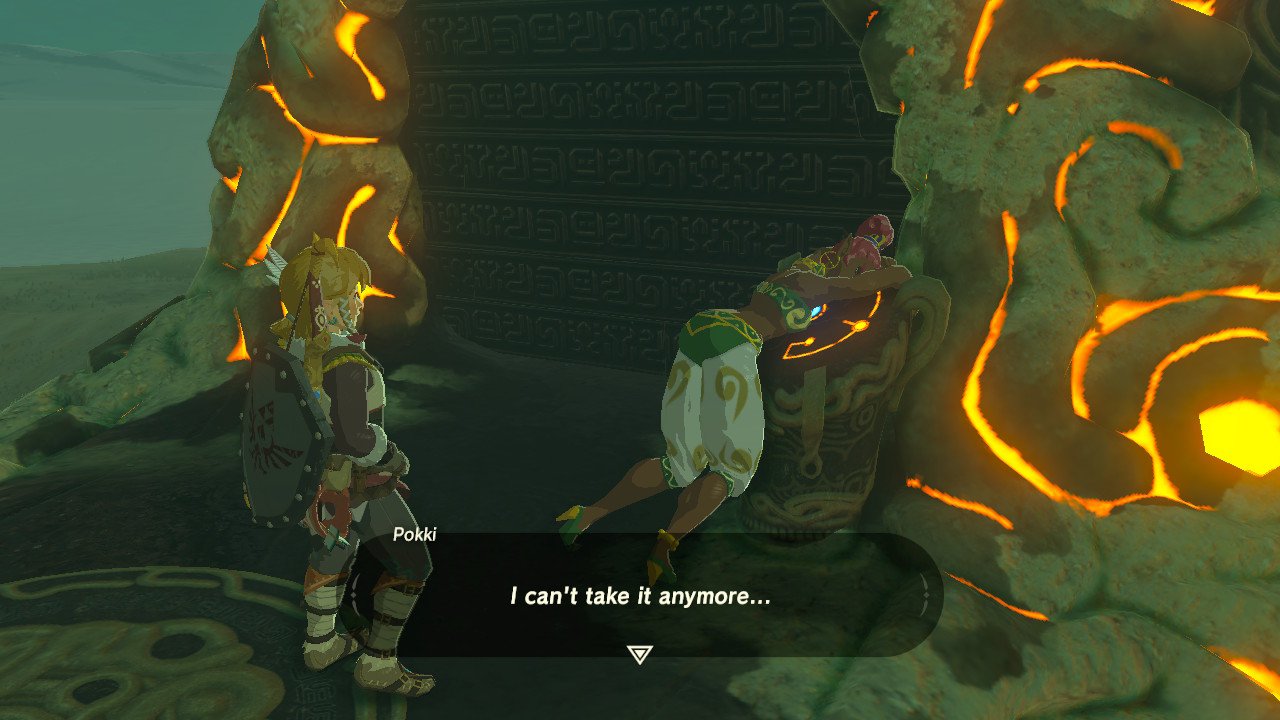
Oh, hey. The combat. I almost forgot about that. I didn’t find it to be particularly remarkable, but it is solid and largely satisfying I suppose. Swinging a sword around and smacking the shit out of things feels pretty good. There isn’t too much variety in weapon sets – you have a couple different types of one handed sword and a couple different types of two handed weapons, bows that are all essentially the same, as well as some rods which fire elemental attacks (not to mention the familiar fire/ice arrows and the like that do the same thing.) I found the blocking and dodging to be a little more awkward than it could have been. Basically this game implemented Witch Time from Bayonetta, except it’s not as accurate. Rather than dodging on reaction when an attack is just about to hit, you have to dodge pretty early which didn’t feel intuitive to me at all. As a result the attack animations aren’t always obvious as to what precise moment you should dodge, so it’s more about memorizing the animations of each type of enemy and learning when the sweet spot is. Ultimately you can just mash the dodge button and you’ll end up getting the slowmo more than half the time anyway. In the grand scheme of things I’d say this game has some of the best combat in a Zelda game to date, though. It’s taken some small steps in a good, fun direction.
So there you have it. Zorldo. Pretty good game, if more open world games were like this maybe I wouldn’t begrudge the concept quite as much, but this particular title does have a lot of failings as a Zelda game. If you want a tl;dr of most of the key points: It’s recaptured a lot of the adventurous feelings that the original Zelda inspired, but sacrificed some of the excellent things that the series had come to be known for, such as dungeons (but can I really say Zelda is known for good dungeons when it hasn’t been for several generations of console at this point? Guess not.) It’s gorgeous, mostly fun, a little annoying at times, but doesn’t feel as repetitive or checklisty as most open world games. Good writing, bad dungeons, okay micro-dungeons, bad inventory and weapon durability systems. Some minor content is locked behind amiibos which is utter horseshit. I guess I didn’t go into detail with that, but basically if you buy the Wolf Link amiibo you can get Wolf Link as a companion in Breath of the Wild and he essentially acts like D-Dog from MGS5. But that content is only available if you buy the physical amiibo. It’s not even a DLC or anything, you just need to buy a physical object which can break or go out of stock. On a fundamental level I really dislike that. I think it’s tacky and shitty. It’s not like you’ll really miss anything by not doing it, but as a business practice I think that’s a dick move. At least let people have the option to replicate the functionality of Wolf Link with a random regular wolf in game or something without needing to buy the damn toy. Also like I mentioned earlier you can only get Epona if you buy the Epona amiibo (but this doesn’t matter because horses are worthless.)
Deciding a grade for this was tough. I really hovered back and forth between C and B. I genuinely had a lot of fun and spent a lot of time with Breath of the Wild, which made me lean toward B. But the flaws are big enough to be considerable detractors. If I’m really being honest the lack of good dungeons is a massive failing, and the poor performance and frame drops are something that I genuinely believe we should be able to avoid these days. It’s 2017 for fuck’s sake. Why are consoles still such fucking garbage? These companies could make something much stronger and still make a profit, but instead they cut every corner and make the consoles as cheap as they possibly can to maximize profits and all it does is hold everything back and result in games with shitty framerates and not even 1080p resolution. FUCKING 2017. This is why I play on PC wherever possible, and you should too. You can put together a custom PC for the price of a console that runs rings around them. Google “potato masher PC build” or anything similar. Also google 9/11 was an inside job. And then google Obama is a lizard person and we never landed on the moon. Wake up sheeple.
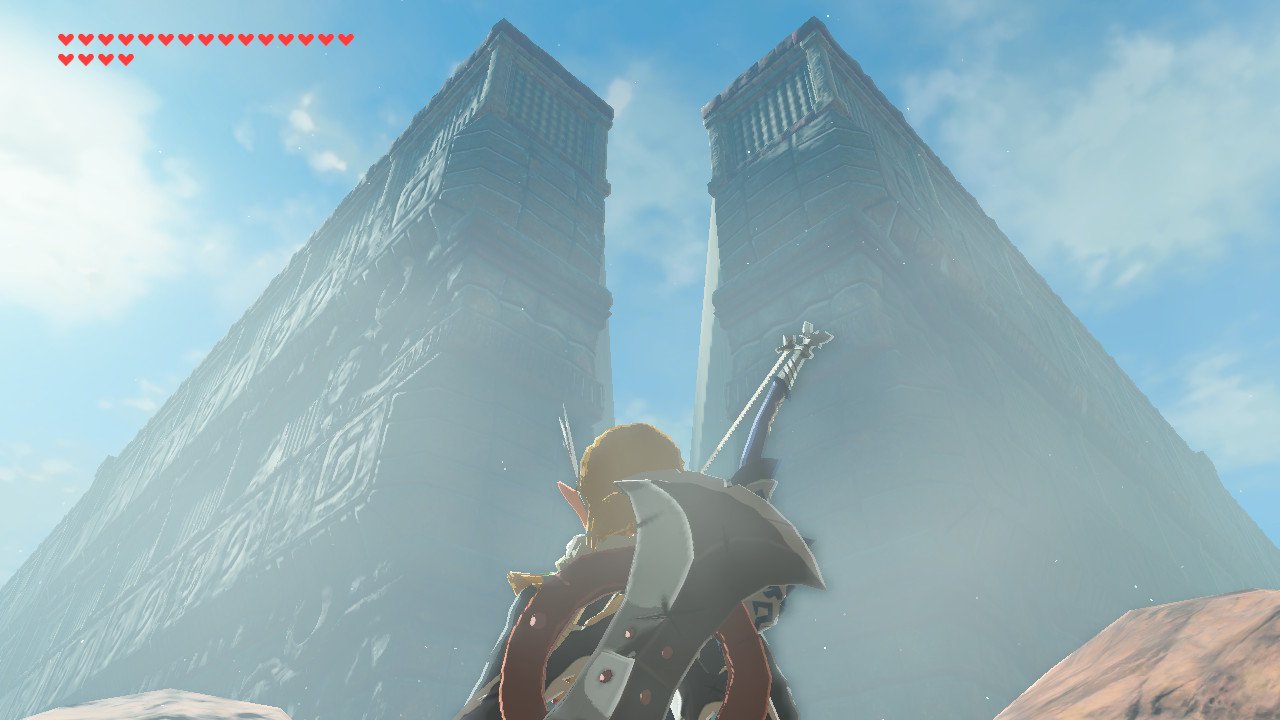
Oh right the grade. I’m gonna give it the benefit of the doubt. I’m being pretty generous here in giving it a B- for being a game that I genuinely had fun playing and didn’t get bored with for a long time. And I really was expecting to give this game a C- at best. I was not expecting good things but it ended up impressing me overall. I think this may be the Ocarina of Time of its age – it will probably continue to be beloved by the masses, and remembered fondly for a very long time, and those who criticize it will be considered haters who just want attention because god forbid anybody dare say anything bad about it. I should be giving this a C- for the dungeons being such complete ass, but this game had some charm, dammit. It won me over in ways I didn’t expect. I just really wish the dungeons had been better, and if they had been this score could easily have been an A.
Am I likely to ever play this game a second time, though? I dunno, not for many years at least. Once you’ve spent a certain amount of time with it you’ll begin to lose interest. In case you never got the memo that’s how open world works. You can only find so many koroks before your interest wanes and you just don’t want to do it anymore. I’ve actually read from a bunch of people that fought Ganon before finishing the rest of the game that they ruined the experience for themselves – now that they’d fought Ganon they didn’t have any interest in playing the rest of the game. No shit! Your only purpose is to beat Ganon and end it, and you’re honestly surprised that you don’t feel the urge to play anymore once you’ve fulfilled that purpose? There were also a ton of complaints that there is no post-game or NG+ and that you revert to your pre-Ganon save when you beat him. You know, like every Zelda ever. Do these people seriously not realize that if it let you keep playing you wouldn’t want to keep playing because there is no longer any reason to do things? Without purpose you’re just in a sandbox, and you soon start to realize that sandbox is full of dog shit.
Final verdict: B-
Final playtime: At least a hundred hours. The fucking Switch doesn’t accurately track time played.